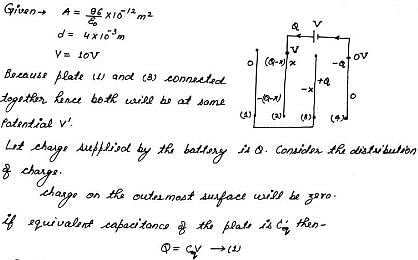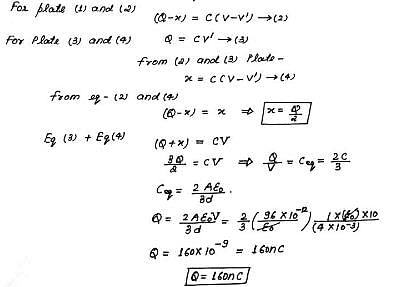NEET Exam > NEET Questions > Each of the plates has surface area A on one ...
Start Learning for Free
Each of the plates has surface area A on one side and the separation between the consecutive plates is d .The emf of the battery connected is E.The magnitude of charge transferred through the battery is?
Verified Answer
Each of the plates has surface area A on one side and the separation b...


 This question is part of UPSC exam. View all NEET courses
This question is part of UPSC exam. View all NEET courses
Most Upvoted Answer
Each of the plates has surface area A on one side and the separation b...
Introduction:
In this scenario, we have a series of plates with surface area A on one side and a separation distance d between consecutive plates. The plates are connected to a battery with an electromotive force (emf) E. We need to determine the magnitude of charge transferred through the battery.
Understanding the Situation:
To understand the situation better, let's break it down into smaller components:
1. Plate Configuration: The plates are arranged in a series, meaning that the positive terminal of the battery is connected to one plate and the negative terminal is connected to the adjacent plate. This creates a uniform electric field between the plates.
2. Electric Field: The electric field between the plates is given by the equation E = V/d, where E is the electric field strength, V is the potential difference between the plates, and d is the separation distance.
3. Charge Transfer: When a potential difference is applied across the plates, charges (electrons in this case) start to move from the negative plate towards the positive plate. This movement of charges is known as charge transfer.
Determining the Charge Transferred:
To determine the magnitude of charge transferred through the battery, we can use the equation Q = CV, where Q is the charge transferred, C is the capacitance, and V is the potential difference.
1. Capacitance: The capacitance of the plate configuration can be calculated using the formula C = εA/d, where C is the capacitance, ε is the permittivity of the medium between the plates, A is the surface area of the plates, and d is the separation distance.
2. Potential Difference: The potential difference between the plates can be obtained from the emf of the battery, which is given by V = Ed, where V is the potential difference, E is the emf, and d is the separation distance.
3. Charge Transfer: Substituting the values of capacitance and potential difference into the equation Q = CV, we get Q = (εA/d) * (Ed), which simplifies to Q = εAE.
Therefore, the magnitude of charge transferred through the battery is given by Q = εAE.
Conclusion:
In this scenario, the magnitude of charge transferred through the battery is given by the equation Q = εAE, where Q is the charge transferred, ε is the permittivity of the medium between the plates, A is the surface area of the plates, and E is the emf of the battery. This equation can be derived by considering the capacitance of the plate configuration and the potential difference between the plates.
In this scenario, we have a series of plates with surface area A on one side and a separation distance d between consecutive plates. The plates are connected to a battery with an electromotive force (emf) E. We need to determine the magnitude of charge transferred through the battery.
Understanding the Situation:
To understand the situation better, let's break it down into smaller components:
1. Plate Configuration: The plates are arranged in a series, meaning that the positive terminal of the battery is connected to one plate and the negative terminal is connected to the adjacent plate. This creates a uniform electric field between the plates.
2. Electric Field: The electric field between the plates is given by the equation E = V/d, where E is the electric field strength, V is the potential difference between the plates, and d is the separation distance.
3. Charge Transfer: When a potential difference is applied across the plates, charges (electrons in this case) start to move from the negative plate towards the positive plate. This movement of charges is known as charge transfer.
Determining the Charge Transferred:
To determine the magnitude of charge transferred through the battery, we can use the equation Q = CV, where Q is the charge transferred, C is the capacitance, and V is the potential difference.
1. Capacitance: The capacitance of the plate configuration can be calculated using the formula C = εA/d, where C is the capacitance, ε is the permittivity of the medium between the plates, A is the surface area of the plates, and d is the separation distance.
2. Potential Difference: The potential difference between the plates can be obtained from the emf of the battery, which is given by V = Ed, where V is the potential difference, E is the emf, and d is the separation distance.
3. Charge Transfer: Substituting the values of capacitance and potential difference into the equation Q = CV, we get Q = (εA/d) * (Ed), which simplifies to Q = εAE.
Therefore, the magnitude of charge transferred through the battery is given by Q = εAE.
Conclusion:
In this scenario, the magnitude of charge transferred through the battery is given by the equation Q = εAE, where Q is the charge transferred, ε is the permittivity of the medium between the plates, A is the surface area of the plates, and E is the emf of the battery. This equation can be derived by considering the capacitance of the plate configuration and the potential difference between the plates.
Attention NEET Students!
To make sure you are not studying endlessly, EduRev has designed NEET study material, with Structured Courses, Videos, & Test Series. Plus get personalized analysis, doubt solving and improvement plans to achieve a great score in NEET.

|
Explore Courses for NEET exam
|

|
Each of the plates has surface area A on one side and the separation between the consecutive plates is d .The emf of the battery connected is E.The magnitude of charge transferred through the battery is?
Question Description
Each of the plates has surface area A on one side and the separation between the consecutive plates is d .The emf of the battery connected is E.The magnitude of charge transferred through the battery is? for NEET 2024 is part of NEET preparation. The Question and answers have been prepared according to the NEET exam syllabus. Information about Each of the plates has surface area A on one side and the separation between the consecutive plates is d .The emf of the battery connected is E.The magnitude of charge transferred through the battery is? covers all topics & solutions for NEET 2024 Exam. Find important definitions, questions, meanings, examples, exercises and tests below for Each of the plates has surface area A on one side and the separation between the consecutive plates is d .The emf of the battery connected is E.The magnitude of charge transferred through the battery is?.
Each of the plates has surface area A on one side and the separation between the consecutive plates is d .The emf of the battery connected is E.The magnitude of charge transferred through the battery is? for NEET 2024 is part of NEET preparation. The Question and answers have been prepared according to the NEET exam syllabus. Information about Each of the plates has surface area A on one side and the separation between the consecutive plates is d .The emf of the battery connected is E.The magnitude of charge transferred through the battery is? covers all topics & solutions for NEET 2024 Exam. Find important definitions, questions, meanings, examples, exercises and tests below for Each of the plates has surface area A on one side and the separation between the consecutive plates is d .The emf of the battery connected is E.The magnitude of charge transferred through the battery is?.
Solutions for Each of the plates has surface area A on one side and the separation between the consecutive plates is d .The emf of the battery connected is E.The magnitude of charge transferred through the battery is? in English & in Hindi are available as part of our courses for NEET.
Download more important topics, notes, lectures and mock test series for NEET Exam by signing up for free.
Here you can find the meaning of Each of the plates has surface area A on one side and the separation between the consecutive plates is d .The emf of the battery connected is E.The magnitude of charge transferred through the battery is? defined & explained in the simplest way possible. Besides giving the explanation of
Each of the plates has surface area A on one side and the separation between the consecutive plates is d .The emf of the battery connected is E.The magnitude of charge transferred through the battery is?, a detailed solution for Each of the plates has surface area A on one side and the separation between the consecutive plates is d .The emf of the battery connected is E.The magnitude of charge transferred through the battery is? has been provided alongside types of Each of the plates has surface area A on one side and the separation between the consecutive plates is d .The emf of the battery connected is E.The magnitude of charge transferred through the battery is? theory, EduRev gives you an
ample number of questions to practice Each of the plates has surface area A on one side and the separation between the consecutive plates is d .The emf of the battery connected is E.The magnitude of charge transferred through the battery is? tests, examples and also practice NEET tests.

|
Explore Courses for NEET exam
|

|
Suggested Free Tests
Signup for Free!
Signup to see your scores go up within 7 days! Learn & Practice with 1000+ FREE Notes, Videos & Tests.























